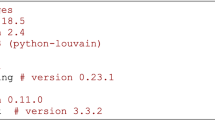Abstract
The objective of this work was to provide a new, precise registration of the cortical mantle with a non-linear transformation. Image registration is broadly classified into two types, using intensity similarity and feature similarity. Whereas the former approach has merit in global brain matching, the latter provides a fast registration centred on a region of interest. The hybrid registration proposed in this paper was achieved using a Bayesian framework, which consisted of a likelihood model including intensity similarity and a prior model including feature information and a smoothing constraint. In this approach, each voxel was spatially transformed, so that the distance between corresponding features was shortened and also so that the intensity correlation was maximised. The result of the hybrid method clearly showed a good match of global brain (r=0.930) by including intensity similarity. Moreover, this method compensated for the approximated sulcus of the feature-based method with intensity information, so that the geometric shape and thickness of the sulcus at the feature-defined region was likely to be registered. The accuracy in the feature-defined area was improved by 33.4% and 7.5% compared with feature-based and intensity-based methods, respectively.
Similar content being viewed by others
References
Amit, Y., Grenander, U., andPiccioni M. (1991): ‘Structural image restoration through deformable templates’,J. Am. Stat. Assoc.,86, pp. 376–387
Ashburner, J., andFriston, K. J. (1999): ‘Nonlinear spatial normalization using basis functions’Human Brain Mapping,7, pp. 254–266
Bezdek, J. C. (1981): ‘Pattern recognition with fuzzy objective function algorithms’ (Plenum Press, New York, 1981)
Bookstein, F. L. (1989): ‘Principal warps: Thin-plate splines and the decomposition of deformations’,IEEE Trans. Pattern Anal. Mach. Intell.,11, pp. 567–585
Bookstein, F. L. (1997): ‘Landmark methods for forms without landmarks: morphometrics of group differences in outline shape’,Med. Image Anal.,1, pp. 225–243
Christensen, G. E., Rabbitt R. D., andMiller, M. I. (1994): ‘3D brain mapping using a deformable neuroanatomy’Phys. Med. Biol.,39, pp. 609–618
Christensen, G. E., Rabbitt, R. D., andMiller, M. I. (1996): ‘Deformable templates using large deformation kinematics’,IEEE Trans. Image Process.,5, pp. 1435–1447
Davatzikos, C. A., Vaillant, M., Resnick, S. M., Prince, J. L., Letovsky, S., andBryan, R. N. (1996): ‘A computerized approach for morphological analysis of the corpus callosum’,J. Comput. Assist. Tomogr.,20, pp. 88–97
Davis, M. H., Khotanzad, A., Flamig, D. P., andHarms, S. E. (1997): ‘A physics based coordinate transformation for 3D image matching’,IEEE Trans. Med. Imag.,16, pp. 317–328
Evans, A. C., Collins, D. L., andHolmes, C. J. (1996): ‘Computational approaches to quantifying human neuroanatomic variability’ inToga, A. W., andMazziotta, J. C. (Eds): ‘Brain mapping: the methods’ (1996)
Friston, K. J., Ashburner, J., Frith, C. D., Poline, J. B., Heather, J. D., andFrackowiak, R. S. J. (1995): ‘Spatial registration and normalization of images’,Human Brain Mapping,2, pp. 165–189
Hill, D. L. G., Hawkes, D. J., Harrison, N. A., andRuff, C. F. (1993): ‘A strategy for automated multimodality image registration incorporating anatomical knowledge and image characteristics’. Proc. Information Processing in Medical Imaging, Flagstaff, USA, pp. 182–196
Lee, S., Wolberg, G., andShin, S. Y. (1997): ‘Scattered data interpolation with multilevel B-splines’IEEE Trans. Vis. Comput. Graphics,3, pp. 228–244
Maes, F., Collignon, A., Vandermeulen, D., Marchal, G., andSuetens, P. (1997): ‘Multimodality image registration by maximization of mutual information’,IEEE Trans. Med. Imag.,16, pp. 187–198
Mazziotta, J. C., Toga, A. W., Evans, A., Fox, P., andLancaster, J. (1995): ‘A probabilistic atlas of the human brain: theory and rationale for its development’,Neuroimage,2, pp. 89–101
Press, W. H., Flannery, B. P., Teukolsky, S. A., andVetterling, W. T. (1992): ‘Numerical Recipes in C’ (Cambridge University Press, Cambridge, UK, 1992)
Rueckert, D., Sonoda, L. I., Hayes, C., Hill, D. L. G., Leach, M. O., andHawkes, D. J. (1999): ‘Nonrigid registration using free-form deformations: application to breast MR images’,IEEE Trans. Med. Imag.,18, pp. 712–721
Sanides, F. (1962): ‘Die architektonik des menschlichen stirnhirms’ inMueller, M., Spatz, H., andVogel, P. (Eds): ‘Monographien aus dem Gesamtegebiete der Neurologte und Psychiatrie’ (Springer-Verlag, Berlin, 1962)
Studholme, C., Hill, D. L. G., andHawkes, D. J. (1996): ‘Automated 3-D registration of MR and CT images of the head’,Med. Image Anal.,1, pp. 163–175
Thompson, P. M., andToga, A. W. (1996): ‘Visualization and mapping of anatomic abnormalities using a probabilistic brain atlas based on random fluid transformations’. Proc. Int. Conf. on Visualization in biomedical computing, pp. 383–392
Trees, D. L. V. (1968): ‘Estimation and modulation theory, Part I’ (John Wiley and Sons, New York, 1968)
Vaillant, M., andDavatzikos, C. A. (1997): ‘Finding parametric representations of the cortical sulci using an active contour model’,Med. Image Anal.,1, pp. 295–315
Vajda, I. (1989): ‘Theory of statistical inference and information’ (Kluwer, Dordrecht, The Netherlands, 1989)
Wahba, G. (1990): ‘Spline models for observational data’ (Society for Industrial and Applied Mathematics, Philadelphia, 1990)
Yoon, U. C., Kim, J. S., Kim, J. S., Kim, I. Y., andKim, S. I. (2001): ‘Adaptable fuzzy c-means for improved classification as a preprocessing procedure of brain parcellation’,J. Digit. Imag.,14, pp. 238–240
Author information
Authors and Affiliations
Corresponding author
Rights and permissions
About this article
Cite this article
Kim, J.S., Lee, J.M., Kim, J.J. et al. Non-linear registration for brain images by maximising feature and intensity similarities with a Bayesian framework. Med. Biol. Eng. Comput. 41, 473–480 (2003). https://doi.org/10.1007/BF02348092
Received:
Accepted:
Issue Date:
DOI: https://doi.org/10.1007/BF02348092




